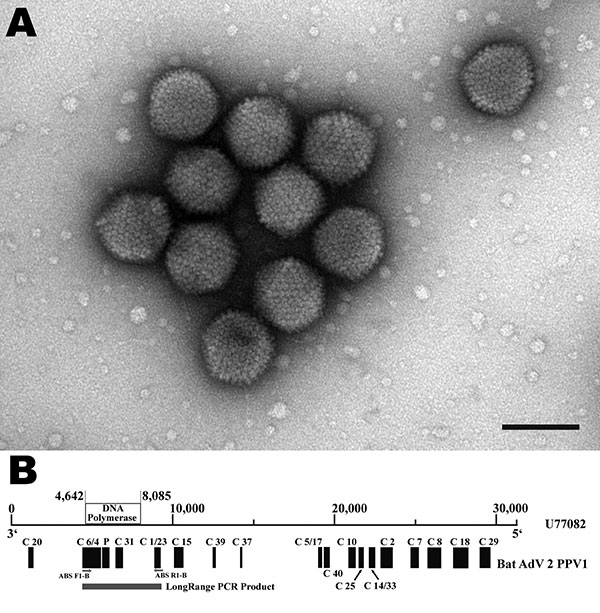Volume 15, Number 12—December 2009
Dispatch
New Adenovirus in Bats, Germany
Figure 1

Figure 1. A) Electron micrograph of adenovirus particles isolated from Pipistrellus pipistrellus bat 199/07, Germany. Negatively stained with 1% uranyl acetate. Virus particles were 70–90 nm in diameter with an icosahedral shape. Scale bar = 100 nm. B) Schematic representation of the genomic fragments obtained from bat adenovirus 2 (GenBank accession no. FJ983127) in correspondence to canine adenovirus 2 strain Toronto A26/61 (GenBank accession no. U77082). Genomic fragments were generated by generic adenovirus-specific PCR (10) and a virus discovery based on cDNA–amplified fragment length polymorphism PCR method (11). Partial sequence of the DNA polymerase gene was generated from LongRange PCR product. Purified PCR products were directly sequenced by using the BigDye Terminator Cycle Sequencing ready Reaction kit (Applied Biosystems, Foster City, CA, USA) and analyzed on an ABI 3770 automatic sequencer (Applied Biosytems). C, clone; P, ≈550-bp nested PCR product.
References
- Wibbelt G, Speck S, Field H. Methods for assessing diseases in bats. In: Kunz TH, Parsons S, editors. Ecological and behavioral methods for the study of bats. Baltimore (MD): Johns Hopkins University Press; 2009. p. 775–794.
- Johnson N, Wakeley PR, Brookes SM, Fooks AR. European bat lyssavirus type 2 RNA in Myotis daubentonii. Emerg Infect Dis. 2006;12:1142–4.PubMedGoogle Scholar
- Halpin K, Young PL, Field HE, Mackenzie JS. Isolation of Hendra virus from pteropid bats: a natural reservoir of Hendra virus. J Gen Virol. 2000;81:1927–32.PubMedGoogle Scholar
- Chua KB, Koh CL, Hooi PS, Wee KF, Khong JH, Chua BH, Isolation of Nipah virus from Malaysian Island flying-foxes. Microbes Infect. 2002;4:145–51. DOIPubMedGoogle Scholar
- Lau SK, Woo PC, Li KS, Huang Y, Tsoi HW, Wong BH, Severe acute respiratory syndrome coronavirus-like virus in Chinese horseshoe bats. Proc Natl Acad Sci U S A. 2005;102:14040–5. DOIPubMedGoogle Scholar
- Calisher CH, Childs JE, Field HE, Holmes KV, Schountz T. Bats: important reservoir hosts of emerging viruses. Clin Microbiol Rev. 2006;19:531–45. DOIPubMedGoogle Scholar
- Wibbelt G, Kurth A, Yasmum N, Bannert M, Nagel S, Nitsche A, Discovery of herpesviruses in bats. J Gen Virol. 2007;88:2651–5. DOIPubMedGoogle Scholar
- Gloza-Rausch F, Ipsen A, Seebens A, Göttsche M, Panning M, Drexler JF, Detection and prevalence patterns of group I coronaviruses in bats, northern Germany. Emerg Infect Dis. 2008;14:626–31. DOIPubMedGoogle Scholar
- Linacre A, Lee JC. Species determination: the role and use of the cytochrome b gene. Methods Mol Biol. 2005;297:45–52.PubMedGoogle Scholar
- Wellehan JF, Johnson AJ, Harrach B, Benko M, Pessier AP, Johnson CM, Detection and analysis of six lizard adenoviruses by consensus primer PCR provides further evidence of a reptilian origin for the atadenoviruses. J Virol. 2004;78:13366–9. DOIPubMedGoogle Scholar
- van der Hoek L, Pyrc K, Jebbink MF, Vermeulen-Oost W, Berkhout RJ, Wolthers KC, Identification of a new human coronavirus. Nat Med. 2004;10:368–73. DOIPubMedGoogle Scholar
- Maeda K, Hondo E, Terakawa J, Kiso Y, Nakaichi N, Endoh D, Isolation of novel adenovirus from fruit bat (Pteropus dasymallus yayeyamae). Emerg Infect Dis. 2008;14:347–9. DOIPubMedGoogle Scholar
- Schrenzel M, Oaks JL, Rotstein D, Maalouf G, Snook E, Sandfort C, Characterization of a new species of adenovirus in falcons. J Clin Microbiol. 2005;43:3402–13. DOIPubMedGoogle Scholar
- Harrach B. Adenoviruses: general features. In: Mahy BW, van Regenmortel MH, editors. Encyclopedia of virology. Oxford: Elsevier; 2008. p. 1–9.